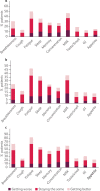Post-COVID symptoms reported at asynchronous virtual review and stratified follow-up after COVID-19 pneumonia
- PMID: 34103378
- PMCID: PMC8313189
- DOI: 10.7861/clinmed.2021-0037
Post-COVID symptoms reported at asynchronous virtual review and stratified follow-up after COVID-19 pneumonia
Abstract
Background: The COVID-19 pandemic has strained healthcare systems and how best to address post-COVID health needs is uncertain. Here we describe the post-COVID symptoms of 675 patients followed up using a virtual review pathway, stratified by severity of acute COVID infection.
Methods: COVID-19 survivors completed an online/telephone questionnaire of symptoms after 12+ weeks and a chest X-ray. Dependent on findings at virtual review, patients were provided information leaflets, attended for investigations and/or were reviewed face-to-face. Outcomes were compared between patients following high-risk and low-risk admissions for COVID pneumonia, and community referrals.
Results: Patients reviewed after hospitalisation for COVID pneumonia had a median of two ongoing physical health symptoms post-COVID. The most common was fatigue (50.3% of high-risk patients). Symptom burden did not vary significantly by severity of hospitalised COVID pneumonia but was highest in community referrals. Symptoms suggestive of depression, anxiety and post-traumatic stress disorder were common (depression occurred in 24.9% of high-risk patients). Asynchronous virtual review facilitated triage of patients at highest need of face-to-face review.
Conclusion: Many patients continue to have a significant burden of post-COVID symptoms irrespective of severity of initial pneumonia. How best to assess and manage long COVID will be of major importance over the next few years.
Keywords: breathlessness; depression; follow-up; long COVID; sequalae.
© Royal College of Physicians 2021. All rights reserved.
Figures



References
-
- Lim WS, Baudouin SV, George RC, et al. . BTS guidelines for the management of community acquired pneumonia in adults: update 2009. Thorax 2009;64:iii1–iii55. - PubMed
MeSH terms
LinkOut - more resources
Full Text Sources
Medical

